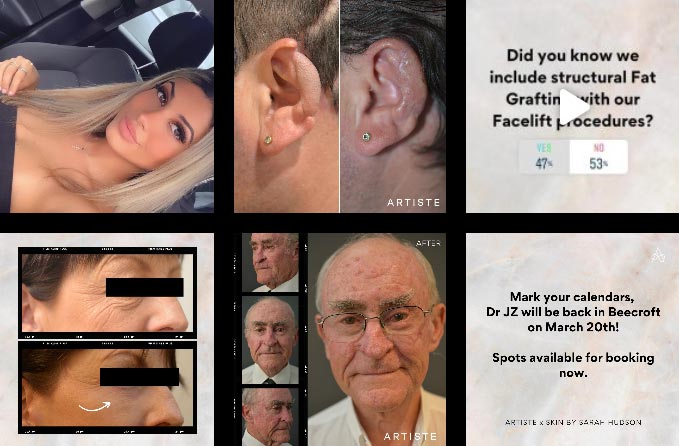Blepharoplasty for Hooded Eyes: Before & After Guide
Model featured in photography
Disclaimer: At Artiste Plastic Surgery, our Plastic Surgeons led by Dr Jack Zoumaras have been trained to the highest possible degree. All surgery has risks and it is always advised to get a second opinion. Risks are very real and we cannot guarantee any result. Results are illustrated as a guide only. All risks are managed and any need for revision surgery or complications (1-5%) can be managed by our specialist plastic surgeons. Any statements on how you will feel is based on Level V Evidence: Level V: How you will feel after plastic surgery varies between individuals, depending on psychological and physical factors. Our internal research is based on how patients in our practice feel after surgery. The blogs/posts are not a substitute for a medical consultation and do not form as part of the doctor to patient relationship.
One facial feature that clients seek plastic surgery for is hooded eyes. This problem can make you appear older or cause obscured or blurred vision.
In this blog, we will cover who a blepharoplasty might suit and what to expect from the procedure.
What are Hooded Eyes?
Hooded eyes occur when excess skin hangs over the natural crease line of the upper eyelid. From an aesthetic point of view, this can make the eyelid look droopy and the eye look smaller or more tired.
They can also cause a functional issue in the form of diminished vision and lack of peripheral vision. This can impact on your ability to complete normal everyday tasks such as reading and driving. The pressure caused by the excess skin can also cause strain around the eye muscles, leading to discomfort or fatigue.
Also known as ptosis or dermatochalasis, hooded eyes are often associated with aging. However, it is also possible to have hooded eyes from birth depending on genetic factors.
Causes of Hooded Eyes
Hooded eyes have multiple causes. These include:
- Genetics
- Aging
- Environmental factors
- Weight loss
Why Someone Might Seek a Blepharoplasty
This procedure may suit individuals who have:
- Excess skin on the lower eyelids
- Baggy or drooping upper eyelids
- Sagging upper eyelids that interfere with vision
- Bags under the eyes
Preparation for a Blepharoplasty
If you decide to opt for a blepharoplasty, you will meet with a specialist plastic surgeon and discuss your case. During this consultation you will:
- Talk about your medical history: your care provider will discuss any medical conditions that impact your eyes, your medications and previous surgeries.
- Talk about your goals: your care provider will ask what you hope to gain from the procedure.
- Be given a full eye exam: this will include measuring your eyelids, checking your visual field and eyelid photography.
You will also be asked to:
- Stop taking any blood thinning medication.
- Stop smoking as this reduces healing.
- Have someone drive you to and from the appointment and stay with you for the first night.
What to Expect From the Procedure
Before the Procedure
You will be given a local anaesthetic via injection into the area around the eyes.
During the Procedure
For the upper eyelid, your plastic surgeon will cut above the eyelid fold and remove excess skin and fat.
For lower lids, a cut will be made just below the eyelashes and excess skin and fat will be redistributed.
If your eyelids droop close to your pupil, your plastic surgeon may also perform a ptosis procedure, which is designed to lift the eyelid by tightening the muscle or tendon above it.
After the Procedure
Once the procedure is complete, you will spend some time in the recovery room to ensure there are no complications. Later that same day, you will be able to go home.
While you heal from the procedure, you may experience:
- Watering eyes
- Double vision
- Puffy and numb eyelids
- Pain or discomfort
- Blurred vision
- Light sensitivity
- Swelling or bruising
Doing the following will help you heal:
- Use prescribed eyedrops
- Apply ice packs every hour on day 1 & reduce this to 4-5 times the following day
- Wear dark glasses to protect your eyes
- Elevate your head above your chest while sleeping
- Take acetaminophen for pain relief
- Rest for the first week
Avoid doing the following:
- Rubbing your eyes
- Smoking
- Wearing contact lenses for 2 weeks
- Take any drugs that might increase bleeding
Interested in a Blepharoplasty?
Artiste Plastic Surgery offers blepharoplasty and a wide range of plastic surgery options. Led by world-renowned specialist Dr Jack Zoumaras, our award-winning practice offers cutting edge treatment. If you would like a consultation, get in touch today via our website or call 02 9327 1700.
SHARE THIS ARTICLE
Oct08
Upper vs Lower Eyelid Surgery: What’s the Difference
Disclaimer: At Artiste Plastic Surgery, our Plastic Surgeons led by Dr Jack Zoumaras have been trained to the highest possible degree. All surgery has risks and it is always advised ...
Oct08
Blepharoplasty for Hooded Eyes: Before & After Guide
Disclaimer: At Artiste Plastic Surgery, our Plastic Surgeons led by Dr Jack Zoumaras have been trained to the highest possible degree. All surgery has risks and it is always advised ...
ABOUT ARTISTE
Artiste Plastic Surgery is an Award Winning Specialist Plastic Surgery practice led by internationally trained Dr. Jack Zoumaras, Plastic Surgeon and Peer Reviewed Face Surgeon
Artiste offers the latest Cosmetic Surgical Procedures of the Face, Breast and Body, inspired from leading centres around the world.
STAY IN THE LOOP
Enter your email address below to receive updates on new articles and VIP access to promotions and special offers.
FOLLOW US ON INSTAGRAM
